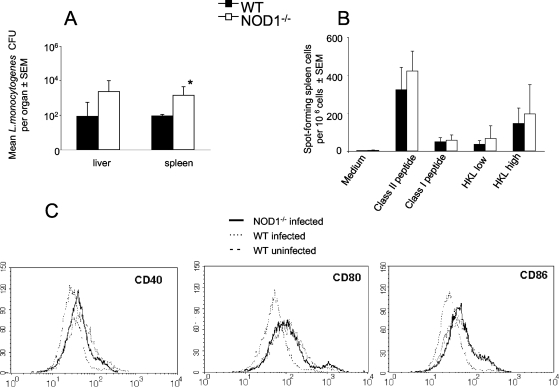FIG. 2.
NOD1 is redundant for induction of adaptive immune responses. Mice infected with 2 × 103 L. monocytogenes CFU were reinfected i.p. with a 50-fold-larger bacterial inoculum 20 days after the primary infection. (A) Mean numbers of L. monocytogenes CFU in livers and spleens from mice sacrificed 4 days after reinfection. The error bars indicate standard errors of the means (SEM). *, P < 0.05 for a comparison with WT mice (Student's t test), indicating a significant difference. (B) Spleen cells from uninfected WT or NOD1−/− mice or from mice 12 days after reinfection with 105 L. monocytogenes CFU (six mice per group) were cultured overnight with or without 2 μM LLO 296-304, 2 μM LLO 190-201, or 0.2 (low) or 0.8 (high) HKL per cell. The data are the numbers of IFN-γ-secreting cells as determined by an ELISPOT assay. All mice showed concanavalin A responses well above 100 SFC per 105 cells, confirming the viability of the splenocyte cultures (data not shown). Uninfected mice showed no SFC following addition of L. monocytogenes whole-cell lysates or following peptide-specific stimulation (data not shown). (C) Spleen CD11c+ DC from NOD1−/− and WT mice at 0 or 4 days after infection with L. monocytogenes were examined by flow cytometry for expression of CD40, CD80, and CD86.

